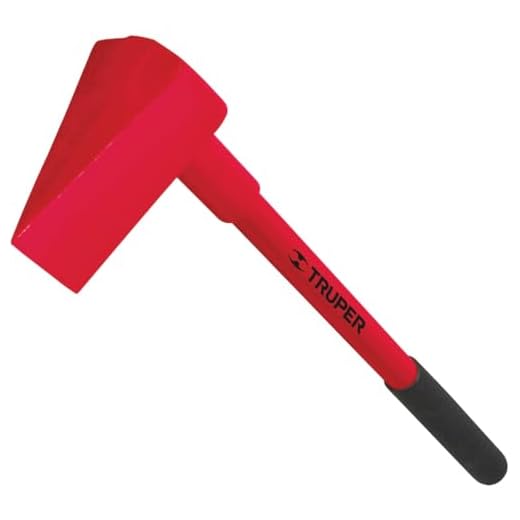




Splitting wood is a common task for those who use firewood as their primary source of heat or enjoy spending time outdoors. While it is generally easier to split seasoned, dry wood, the question arises: can you split green wood with an axe?
The answer is yes, you can split green wood with an axe, but it may require more effort and technique compared to splitting dry wood. Green wood, also known as unseasoned wood, contains more moisture and is generally harder to split due to its higher water content. The moisture in green wood makes it more flexible, which can absorb some of the impact from the axe.
When splitting green wood, it is important to have the right tools and techniques. Using a sharp axe with a thin and narrow blade, such as a splitting maul or a wedge, can help you effectively split green wood. Additionally, using a log splitter or a sledgehammer and wedges can provide extra power and make the task easier.
It is worth mentioning that splitting green wood may require more physical strength and stamina. Due to its moisture content, green wood can be heavier and more resistant to splitting compared to dry wood. Therefore, it is essential to use proper body mechanics and take breaks when needed to prevent fatigue and reduce the risk of injury.
Splitting Green Wood: Axe vs. Other Tools
When it comes to splitting green wood, using the right tool is crucial for efficiency and safety. While an axe is a popular choice for many, there are also other tools that can be effective for this task. Let’s explore the benefits and drawbacks of using an axe compared to other tools.
Axe
An axe is a versatile tool that has been used for centuries to split wood. Its heavy head and sharp blade make it well-suited for tackling even the toughest green wood. Here are a few advantages of using an axe:
- Powerful strikes: The weight and design of an axe allow for powerful strikes that can easily split green wood.
- Greater control: With an axe, you can have more control over the splitting process, ensuring cleaner and more accurate splits.
- Traditional tool: Using an axe can be a satisfying and fulfilling experience, especially for those who appreciate the traditional and hands-on approach to wood splitting.
However, there are a few drawbacks to using an axe as well:
- Physical exertion: Splitting green wood with an axe can be physically demanding, requiring strength and stamina.
- Skill required: Proper technique and experience are necessary to effectively and safely use an axe for splitting wood.
Other Tools
While an axe is a popular choice for splitting green wood, there are other tools that can make the task easier and more efficient:
- Wood Splitting Maul: Similar to an axe, a wood splitting maul is designed specifically for splitting wood. It has a heavier head and a wider blade, making it ideal for splitting larger logs and tough green wood.
- Log Splitter: For those who have a large amount of wood to split, a log splitter can be a great investment. These machines use hydraulic power to split wood quickly and efficiently, requiring less physical exertion.
- Wedge and Hammer: Another option for splitting green wood is to use a wedge and a hammer. By driving the wedge into the wood with a hammer, you can effectively split the wood apart.
Ultimately, the choice of tool for splitting green wood depends on personal preference, available resources, and the amount of wood that needs to be split. Whether you decide to use an axe, a wood splitting maul, a log splitter, or a wedge and hammer, it’s important to prioritize safety and proper technique to prevent accidents and injuries.
Benefits of Splitting Green Wood
1. Easier splitting: Splitting green wood is generally easier than splitting dry wood. Green wood is softer and more flexible, making it easier to split with an axe.
2. Faster drying: Splitting green wood exposes more surface area to the air, allowing it to dry more quickly. This can be especially beneficial if you need the wood to be dry for use as firewood or for woodworking projects.
3. Improved burning: Splitting green wood can lead to more efficient and cleaner burning. Green wood contains higher levels of moisture, which can cause it to burn less efficiently and produce more smoke. By splitting the wood, you can reduce the moisture content and improve its burning properties.
4. Reduced risk of insects and decay: Splitting green wood can help prevent insects and decay from damaging the wood. By exposing the inner layers of the wood, you allow it to dry more quickly and reduce the risk of insects and decay taking hold.
5. Increased availability: Green wood is often more readily available than dry wood. This can be advantageous if you need a large quantity of wood for a project or if you rely on wood as a fuel source.
6. Health benefits: Splitting green wood can be a physically demanding activity, providing a good workout for your muscles and cardiovascular system. It can help improve your strength, coordination, and overall fitness.
In conclusion, splitting green wood with an axe offers several benefits, including easier splitting, faster drying, improved burning, reduced risk of insects and decay, increased availability, and health benefits. Whether you need firewood or wood for a project, splitting green wood can be a practical and rewarding task.
The Importance of Choosing the Right Axe
When it comes to splitting green wood with an axe, selecting the right tool for the job is crucial. A well-chosen axe can make the task easier, more efficient, and safer. Here are a few reasons why choosing the right axe is important:
|
1. Efficiency: Using the correct axe for the job can greatly improve efficiency. Different types of axes have different designs and cutting edges that are specifically suited for certain tasks. For splitting green wood, a splitting axe with a heavy head and a wedge-shaped blade is typically the best choice. It can easily split the wood along the grain, making the job faster and less strenuous. |
2. Safety: Choosing the right axe can also significantly improve safety. Using an axe that is too heavy or too light for the task at hand can lead to accidents and injuries. A well-balanced axe with a comfortable and secure grip can help maintain control and minimize the risk of accidents. Additionally, using an axe with a properly sharpened blade and a sturdy handle can reduce the chances of the axe getting stuck or bouncing off the wood, which can be dangerous. |
|
3. Durability: Investing in a high-quality and durable axe can save you money in the long run. Cheap axes with low-quality materials and construction may not withstand the demands of splitting green wood and can quickly become damaged or ineffective. On the other hand, a well-made axe with a strong handle and a sharp blade can last for years, providing reliable performance and making your wood-splitting tasks easier and more enjoyable. |
4. Versatility: Lastly, choosing the right axe can offer versatility. While the main purpose may be splitting green wood, a well-chosen axe can also be used for other tasks such as felling trees, limbing branches, or shaping wood. By selecting an axe with a design and features that cater to your specific needs and preferences, you can ensure that it will be a versatile tool that you can rely on for various outdoor projects. |
Overall, when it comes to splitting green wood with an axe, selecting the right tool is essential. By considering factors like efficiency, safety, durability, and versatility, you can make an informed decision and choose an axe that will make your wood-splitting tasks easier, more efficient, and more enjoyable.
Tips for Splitting Green Wood with an Axe
Splitting green wood with an axe can be a challenging task, but with the right technique and tools, it can be done effectively. Here are some tips to help you get started:
1. Use a sharp axe
Using a sharp axe is crucial when splitting green wood. A sharp blade will make it easier to cut through the wood and reduce the risk of accidents. Regularly sharpen your axe to maintain its efficiency.
2. Choose the right axe
Using the right axe for splitting green wood is important. Look for an axe that has a thin blade and a wide cutting edge. This type of axe will penetrate the wood more easily and create cleaner splits.
3. Prepare the wood
Prior to splitting, prepare the wood by removing any knots or branches that may interfere with the splitting process. This will make it easier to position the axe and reduce the risk of the wood splitting in an unintended direction.
4. Position yourself correctly
When splitting green wood, stand with your feet shoulder-width apart and position yourself in front of the log. Maintain a firm grip on the axe handle, and position your body in a way that allows you to generate maximum force when swinging the axe.
5. Use the right swinging technique
Swing the axe overhead and bring it down with force onto the center of the wood. Aim for a spot where you can see cracks or natural weaknesses in the wood. Use your body weight and momentum to help drive the axe through the log.
6. Be cautious of rebound
When splitting green wood, there is a higher chance of the axe bouncing back or getting stuck in the wood. Be cautious of this rebound effect and always be prepared to react quickly in case the axe does not go through smoothly.
7. Take breaks
Splitting green wood can be physically demanding. Take regular breaks to rest and rehydrate. This will help prevent fatigue and reduce the risk of accidents caused by exhaustion.
By following these tips, you will increase your chances of successfully splitting green wood with an axe. Remember to always prioritize safety and take your time to ensure accurate and efficient splits.
Safety Precautions when Splitting Green Wood
Splitting green wood with an axe can be a challenging and potentially dangerous task. However, by following proper safety precautions, you can minimize the risks and ensure a safe and successful wood-splitting experience.
1. Wear Protective Gear
Prior to splitting green wood, always make sure to wear appropriate protective gear. This should include a pair of heavy-duty work gloves to protect your hands from blisters and splinters, safety glasses or goggles to shield your eyes from flying wood chips, and sturdy footwear to protect your feet.
2. Choose the Right Axe
Using the right type of axe is crucial for splitting green wood effectively and safely. Look for an axe specifically designed for splitting wood, preferably one with a weighted head and a long handle. Make sure that your axe is sharp and well-maintained to ensure clean and efficient cuts.
3. Find a Suitable Work Area
When splitting green wood, it’s essential to have a designated work area that is clear of any potential hazards. Find a level, stable surface outdoors, away from any buildings, vehicles, or other objects that could be damaged. Remove any obstacles or debris that may cause you to trip or lose balance while swinging the axe.
4. Use Proper Splitting Techniques
Using the correct techniques when splitting green wood can help prevent injuries and accidents. Start by positioning the log securely on the chopping block, ensuring that it won’t roll or move while you’re splitting. Stand with your feet shoulder-width apart and maintain a firm grip on the handle, keeping your body weight centered and balanced. Swing the axe using controlled, fluid motions, focusing on the accuracy of your strikes rather than speed.
5. Keep Others at a Safe Distance
Always make sure there is a safe distance between you and any bystanders or helpers while splitting green wood. Flying wood chips and the potential for the axe to bounce back can cause serious injuries if someone is standing too close. Keep children and pets away from the work area to prevent accidents.
6. Regularly Inspect Your Axe
Inspecting your axe before each use is essential for safety. Check the handle for any cracks or splintering and ensure that the head is securely attached. Make sure the blade is sharp and free of any nicks or damage that could cause it to break during use. If you notice any issues with your axe, repair or replace it before continuing with the splitting process.
Remember, splitting green wood with an axe requires concentration, skill, and caution. By following these safety precautions and using proper techniques, you can successfully split wood while minimizing the risk of accidents and injuries.
Alternative Methods for Splitting Green Wood
If you don’t have access to an axe or if you prefer not to use one, there are alternative methods you can try for splitting green wood. These methods require some different tools and techniques but can be just as effective.
Method 1: Using a Wedge and Maul
A wedge and maul are similar to an axe, but the maul typically has a heavier head and a longer handle. To use this method, follow these steps:
- Place the green wood log on a sturdy chopping block.
- Position the wedge on the end of the log, making sure it’s centered.
- Using the maul, strike the end of the wedge with a steady and controlled swing.
- Continue striking the wedge until the log splits.
Method 2: Using a Splitting Maul
A splitting maul is a heavier and thicker version of an axe. To use this method, follow these steps:
- Place the green wood log on a stable surface, such as the ground.
- Hold the splitting maul with both hands at the end of the handle.
- Lift the maul over your head and bring it down with force onto the log.
- Repeat this motion until the log splits.
Method 3: Using a Manual Log Splitter
A manual log splitter is a specialized tool designed for splitting wood. To use this method, follow these steps:
- Place the green wood log into the log splitter.
- Operate the lever or handle to apply pressure to the log.
- Continue applying pressure until the log splits.
Remember to always follow safety precautions when splitting wood, regardless of the method you choose. Wear protective gear, such as gloves and safety glasses, and make sure you have a clear and safe work area.
By using these alternative methods, you can successfully split green wood without the use of an axe. Choose the method that works best for you and enjoy the satisfaction of splitting wood for your next project.








